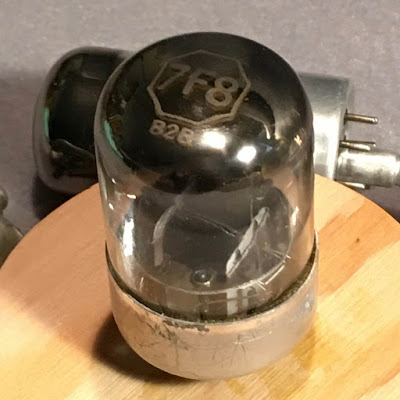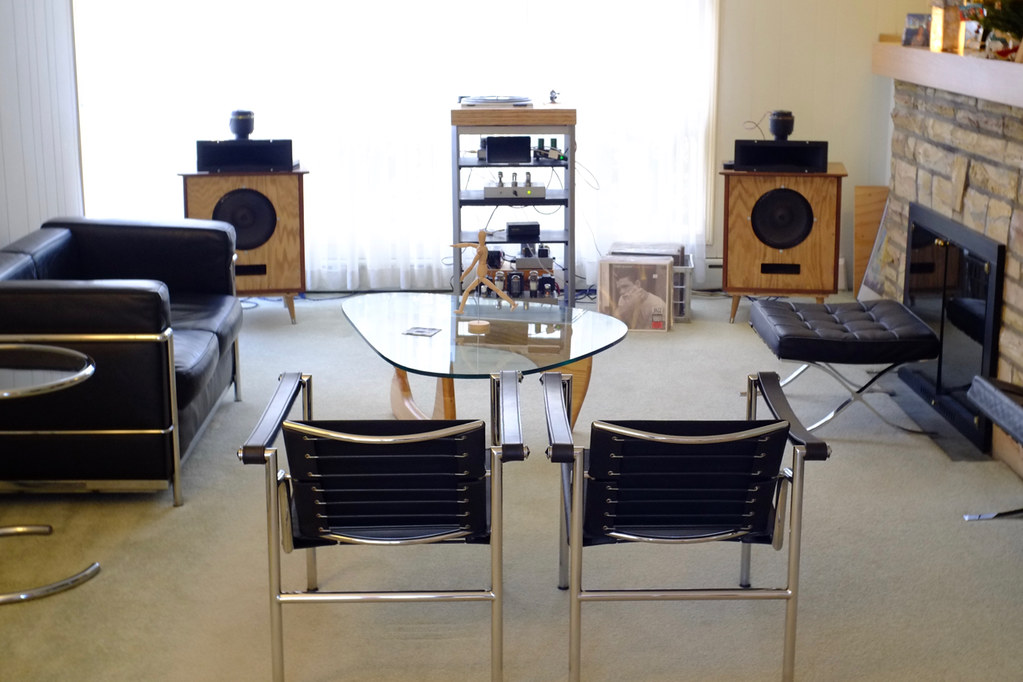Sunday, March 25, 2018
XtremPro X1 USB DAC
Thursday, March 8, 2018
Audio Silente parts for the Thorens TD124 + Mk. II
 |
| Thorens TD 124 Mk. I + Stax UA3NL |
My Thorens TD 124 Mk. I and Mk. II have seen so much action and deserved pampering.
The heavy iron platter created a "dome" on the main bearing end cap of the Mk. I.
Both sides of its original Nylatron thrust pad were dented. So this past weekend I went on eBay and ordered two sets of 6mm bronze end caps that each came with two plastic thrust pads and gaskets, an idler wheel + a few other TD 124 bits from Simone Luchetti of Audio Silente.
 |
| Backyard around 11am, 3/7/18 |
Shipping was swift, the parts were delivered by FedEx from Rome, Italy yesterday morning before the height of the blizzard.
I started work on the main bearing of the Mk. I.
Fit and finish are first rate!
Since the unit was already on the work bench, I cleaned and lubricated the motor also.
Although the original main bearing end cap on the Mk. II was not as dented as the Mk. I, I also replaced it for future generations. 😁
Given the attention to detail Swiss engineers put into the design of the TD 124, that flimsy main bearing end cap was a gross oversight. The finely machined 6mm bronze end cap from Audio Silente definitely adds structural integrity to the main bearing. I also noticed that the platter spins at least twice as long after the motor is shut off = less friction.
While testing the Audio Silente idler wheel on the bench, I realized that even if the rubber was still supple on my original idler wheels, the bearings were not as silent as the Audio Silente idler, perhaps due to wear. While deciding whether to order another idler wheel from Simone or Oilite bearings from the Spanish guy, we lost power...😞
With about 2 hours left of daylight, I consoled myself by looking at audio porn. 😎
 |
| Thorens TD 124 Mk II + Audio Technica AT1501-II |
The idler wheel comes with 3 extra O-rings - 2 red and another black. Because the pre-installed black O-ring already starts faster than my stock idler wheel, I did not try the red silicon O-ring which is supposed to give an even quicker start.
The Audio Silente idler wheel truly lives up to its company name. I had never been able to bring the performance of my TD 124s to this level of silence.
Reference
Tuesday, February 20, 2018
Conquering RFI in the 2C22/7193
 |
| Noisy and unstable 2C22/7193 |
A 150 ohm 1/2W CC resistor with the leads cut short soldered in series with the grid cap (insulate with heat shrink tubing) >> shielded cable terminated by an RCA plug (shield connected only at the RCA jack side) >> RCA jack (barrel grounded to chassis) solved the stability issue.
 |
| A well behaved 2C22/7193 |
Thursday, February 1, 2018
Altec 32A, 32C, Emilar EH1210, EH800, EH500 and Faital Pro STH100
+
Altec 32A and 32C
 |
| Altec 32A (top) Altec 32C (bottom) |
Altec 32A
 |
| Altec 32A |
 |
| Altec 32A + 802 + 414A |
Metal or plastic?
It's ironic that the later plastic 32C sounds more vintage than the earlier metal 32A. Definitely, the longer throat of the earlier 32A and the type of material used for construction influence the sound. But in what capacity, I cannot surely define. The iPhone RTA results reinforce the cooler and more modern sound I hear from the metal 32A versus the warmer and sweeter plastic 32C.
The magnitude of difference is not great. Similar to the 20275 vs. 34852 Altec 1" aluminum diaphragms - distinct enough not to be used as a stereo pair but still excellent performers in their own right. However, those who are expecting a front-row presentation may find both these horns too laid back.
Watch out for roughly finished throat edges in the 32A which are detrimental to performance. So far all the plastic 32Cs I've seen have very smooth throats.
Emilar
EH1210
 |
| Emilar EH1210 |
 |
| Emilar EH1210 + 802 + 414A |
Emilar "Bowtie" EH800 and EH500
 |
| Emilar EH500 (left) + Emilar "Bowtie" EH800 (right) |
EH800
 |
| Emilar "Bowtie" EH800 |
 |
| EH800 + 802 + 414A |
EH500
 |
| EH500 |
 |
| EH500 + 802 + 414A |
EH500 in Large Format Mode
 |
| EH500 sans adaptor + Renkus-Heinz SSD3301 |
Late addition:
Faital Pro STH100
 |
| Faital Pro STH100 |
 |
| STH100 + 802 + 414A* *RTA was done at a later date in another location, hence the difference in low frequency response |
CODA
Wednesday, January 17, 2018
Wednesday, January 3, 2018
Altec 2-way XO Redux
 |
| JEL N1600 Crossover |
 |
| JEL N1600C + HF EQ optimized for the 802 driver fitted with the original 16 ohm 20275 diaphragm |
 |
| JEL Universal Altec 2-way XO |
 |
| JEL Universal Altec 2-way XO with HF EQ circuit |
Simplest Crossover
Sunday, December 24, 2017
Happy Holidays and a Great New Year to All!
2017 Index
Friday, December 15, 2017
JE Labs Loctal Preamp
Loctal tubes
The concept of this project was to build a full function stereo preamp utilizing loctal tubes based on the schematics below.
Preamp circuit
!!!WARNING!!!
The voltages found in this circuit can be lethal!
Build at your own risk!!!
 |
| Power Supply |
 |
| 5AZ4 rectifier = 5Y3 on a loctal base |
Line Stage
 |
| The 7AF7 is very similar to the 7N7 and 6SN7 but has slightly less transconductance and inter-electrode capacitance |
 |
| 7N7 = loctal based 6SN7 |
Phono
 |
| 100Hz/1kHz/10kHz square waves (top = input/bottom = output) from the Loctal EAR 834P phono section |
 |
| 7F7 = 6SL7 on a loctal base |
Tube rolling loctal style
 |
| I've been tweaking and listening to this preamp for the past 6 months. |
 |
| Warning: 7F8 is NOT plug-in compatible with the 7N7 and 7AF7 |
I initially set up the phono section to use the unique 7F8 loctal in the cathode follower position, hoping that the 7F8's greater transconductance will produce a darker and more robust sound. But ultimately, it was the ubiquitous 7N7 (loctal 6SN7) that gave me the tonal balance I wanted, with the 7AF7 as alternate.
With an amplification factor of 48, the 7F8 may not have enough gain as a phono preamp with the RIAA EQ in the negative feedback loop. However, it was too much for a zero feedback single stage line amp.
Typically, I don't split halves of twin triodes for left and right channels. I made an exception in wiring this line stage so that I could exploit the 7AF7 vs. 7N7 comparisons and usage options.
My ears finally chose the 7AF7 as the voltage amplifier for the line stage. The slightly lower transconductance and amplification factor mimics the exotic tonal qualities of its grandad, the 76. Each half of the 7AF7 is direct coupled to half of a 7N7 configured as the cathode follower. This combination is as close as I could get to my 76/6SN7 line stage.
But don't limit yourself to this report, use it as a starting point for your loctal tube rolling adventure. 😉
Which is better?
or
Both are here to stay. 😎
🎅🎅🎅 Happy holidays and merry listening! 🎄🎄🎄




























